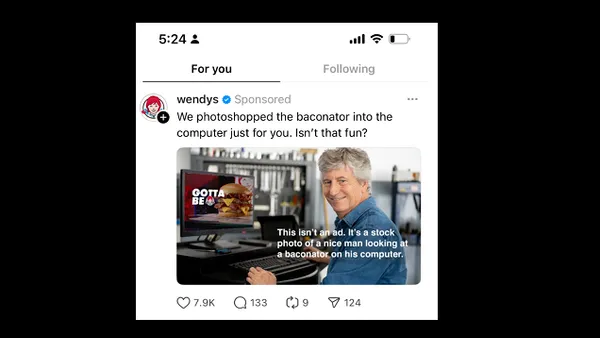Dive Brief:
- Digital ad spending continued to rebound during the holiday season, though there are signs of a "return to normalcy" in activity among Google, Amazon and social media platforms. Store visits fell 22% in 2020's fourth quarter from a year earlier, and travel ad spend declined 20%, though trends are emerging that indicate a steady return to pre-pandemic levels, Dentsu-owned marketing agency Merkle announced.
- Google's yearly ad spend growth rose 12% in Q4 from 11% in the prior quarter, as cost per click (CPC) growth climbed for the first time since Q1 2020. Paid search clicks also rose 12%, which marked a deceleration to levels seen in Q1 2020 but still helped to generate growth in overall ad spending.
- Amazon's delay in its yearly Prime Day shopping event drove a 57% yearly gain in sponsored product ad spend, up from 50% in Q3. Average CPCs rose 8% in Q4, reversing three quarters of declines. Facebook's spending growth was steady as cost per mille (CPM) rose 10% during the holiday quarter, the first gain since Q1 2020, according to Merkle.
Dive Insight:
Digital media spending was stronger during the holiday season as marketers sought to reach homebound shoppers and reverse declines brought on by the coronavirus pandemic. Merkle now reports signs of that activity among Google, Amazon and social media platforms returning to pre-pandemic levels. Brick-and-mortar retailers and travel-related businesses that bore the brunt of the pandemic signal recovery, though store visits and ad spending for travel were still lower at the end of 2020 than in the prior year.
Among other signs of a return to some normalcy, mobile phones made up 64% of total paid search clicks on Google in Q4 to reach pre-pandemic levels. Desktop traffic rose as consumers spent more time at home, and tablets increased their share of traffic as the growth rate inched up to 4% in Q4 from 3% in the prior quarter. The share of Google Shopping ad clicks for local inventory ads (LIAs) in Q4 remained below pre-pandemic levels, but were better than those from the prior quarter. LIA click share averaged 15% in October and November, compared with 25% in early Q1 2020.
Amazon benefited from the move in Prime Day to the fourth quarter, though increased competition and inventory constraints slowed yearly ad sales growth. The e-commerce giant last year offered several new sponsored formats and placements that shifted ad spend from traditional placements. Amazon's sponsored products ad format remained the strongest in sales-per-click measures, while relative sales-per-click for sponsored brand ads slipped to 96%, Merkle found, suggesting that Amazon and its ad business were strengthened from hosting a belated Prime Day event to wrap up the year.
As for social media platforms at the tail end of 2020, Facebook saw gains as advertisers boycotting the platform earlier in the summer returned and political ads ramped up before the election. Instagram experienced similar growth, with its Stories format gaining share to make up 33% of ad spend among participating advertisers, per Merkle. While spending on Instagram ads jumped 30% in Q4 from a year earlier, the growth rate was slower than seen in Q3. Pinterest's share of social media ad spending was 14%, besting Snapchat and Twitter at 12%, and suggesting its newer ad formats and recent features drew appeal from marketers.














